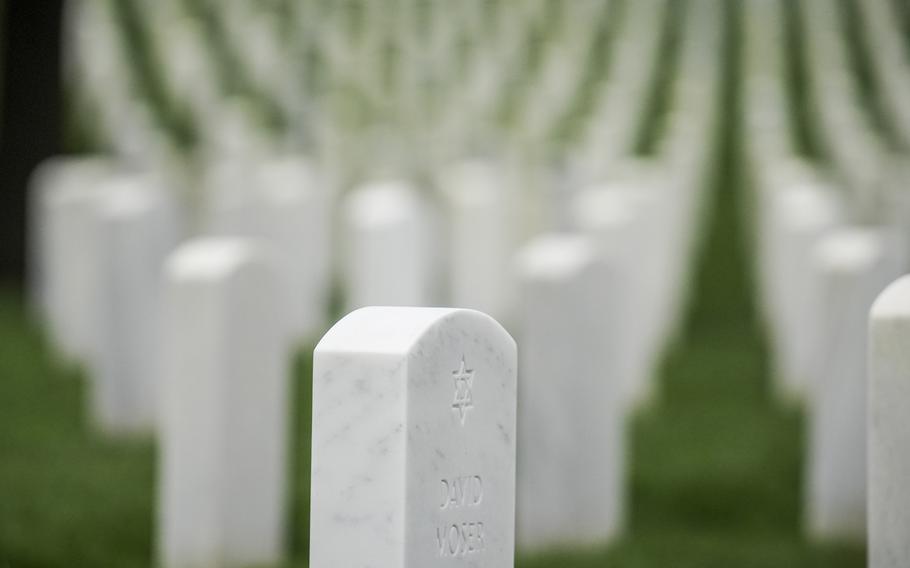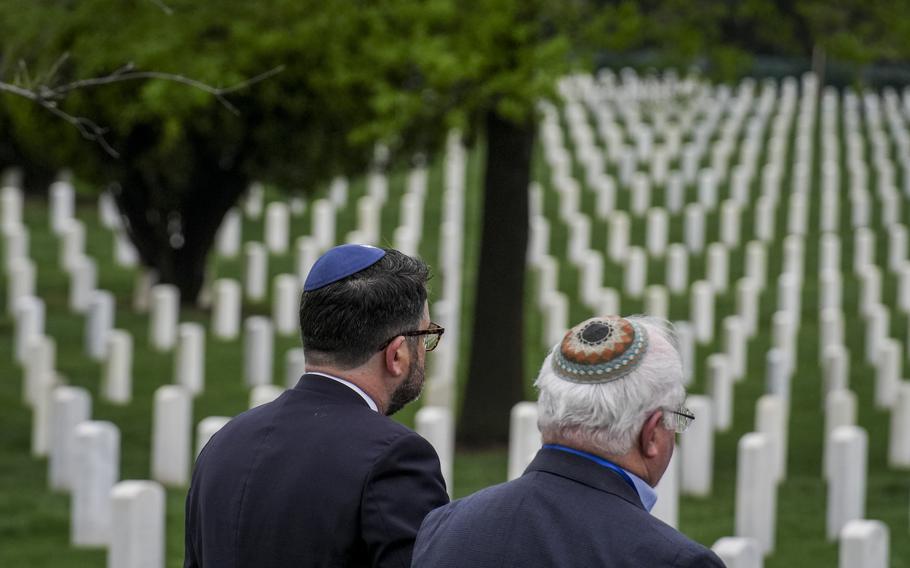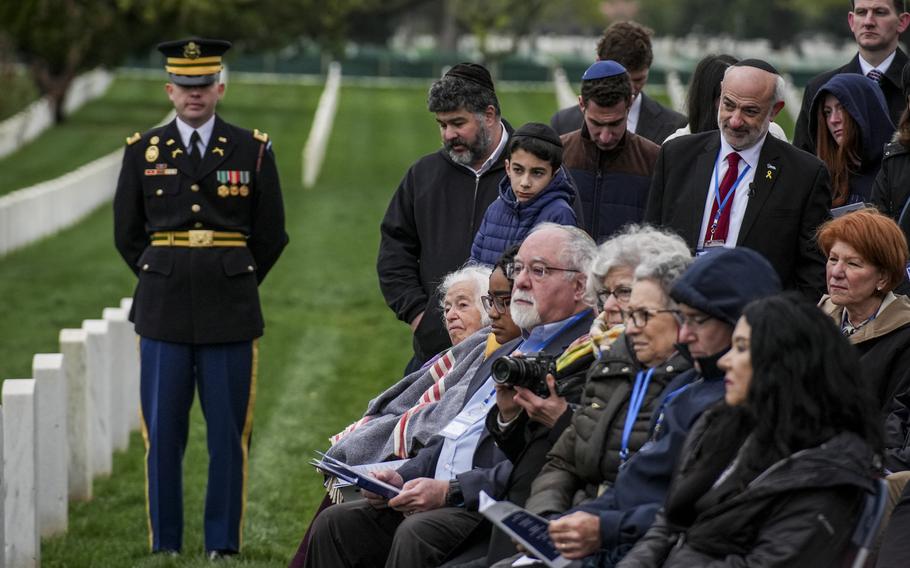
The new tombstone of Army Pvt. David Moser, who died of influenza while fighting in World War I. (Jahi Chikwendiu/The Washington Post)
Deborah Berlinger Eiferman rose from her wheelchair and was helped to the lectern set up in the grass near the grave of her uncle, Army Pvt. David Moser — her “baby uncle” as she called him — in Arlington Cemetery.
She is 102. He was 20 when he died, a Jewish soldier killed by influenza in 1919 in Germany after fighting in World War I. But for over a century he had been in Arlington beneath a tombstone mistakenly incised with the Christian cross.
As about 100 people gathered in the cemetery under gray skies on Monday, Eiferman, of Riverdale, New York, watched officials remove a canvas shroud covering a new marble tombstone bearing the Star of David at Moser’s grave.
“I am so grateful,” she told those present. “It’s an overwhelming experience. … As Jewish people, we are grateful.”
She said she called Moser her baby uncle, and everyone in her family called him baby David, because he did not live beyond 20. He was 18 — “a proud Jew” — when he enlisted in the Army, two weeks after the United States entered the war in 1917, she said. Two years later, he was dead.
His body was returned to Arlington and buried under the Christian tombstone in 1920. None of his family was able to attend, Eiferman wrote in a letter last year to Karen Durham-Aguilera, executive director of the Office of Army Cemeteries.
Now, Eiferman said, it was a miracle that his faith was being recognized as he rested among his comrades and a miracle that she was there to witness it.
Moser was one of two Jewish soldiers whose corrected tombstones were unveiled in the cemetery Monday.
The other was Pfc. Adolph Hanf, a Polish immigrant from Detroit who was killed in France in 1918. He was 34 and had become a naturalized U.S. citizen the year before.
His body was brought to Arlington and buried there on May 11, 1922, according to government records. An official burial card states: “Star of David to be inscribed on headstone.”
But for unknown reasons, his headstone was etched with a cross. His family was apparently unaware of the mistake and the error went uncorrected for more than a century.
Officials said Hanf has no known living relatives. So those attending the unveiling of Moser’s tombstone went to observe the unveiling of Hanf’s a short distance away. “Adolph, you’re not alone,” Eiferman said.
A cemetery spokeswoman said the new tombstones were put in place earlier this year. The old stones were removed and destroyed.
The tombstone errors were discovered by Operation Benjamin, a nonprofit that combs through historical records to make sure American Jewish soldiers buried in Europe and the U.S. are beneath tombstones that reflect their faith.

Two Jewish World War I veterans, Pvt. David Moser and Pfc. Adolph Hanf, were buried under tombstones with Christian crosses until now. The new tombstones with the Star of David were unveiled in a ceremony at Arlington National Cemetery on Monday. (Jahi Chikwendiu/The Washington Post)
Working with the American Battle Monuments Commission, which maintains American military cemeteries overseas, the organization says it has corrected the headstones of more than 30 U.S. Jewish soldiers.
“Many Jews didn’t want to be identified as Jews,” Operation Benjamin’s chief historian and co-founder, Shalom Lamm, said in a recent telephone interview. “Either they were afraid of being captured, certainly in World War II. But in World War I, there was plenty of antisemitism.”
If they were killed and had not identified as Jewish, “graves registration would put them under a Latin cross, very logically,” he said.
And if the body of a Jewish soldier bore no identification, graves officials would assume he was Christian, because most soldiers were, Lamm said. “And that made good sense,” he said. “These weren’t purposeful things. They were mistakes or accidents.”
In addition, he said, many slain soldiers were buried, exhumed and reburied multiple times before reaching their final resting place. The possibility of mistakes was significant, he said. “The amazing thing is not that there are so many mistakes. It’s that there are so few mistakes. But those mistakes are there.”
He said he estimates that for World Wars I and II there are between 800 and 900 Jewish soldiers buried incorrectly under a marker of a Christian faith: “We’re there to correct those mistakes.”
He said the organization begins by checking lists of buried soldiers with common Jewish names. “It’s certainly a little bit unscientific,” he said. But “it’s a good starting place.”
“We do a huge amount of research,” he said. “We do a lot of research on soldiers that turn out to be properly buried. And that’s okay.”
Lamm said Operation Benjamin discovered Eiferman’s link to Moser and contacted her in December. “There was a mix of disbelief and joy,” he said. Eiferman then wrote to the cemetery, which on Jan. 10 approved the change.

Eiferman, seated at left, and others attend the ceremony at Arlington National Cemetery. (Jahi Chikwendiu/The Washington Post)
The operation presented its research on Hanf to the cemetery, which approved the change in February, he said.
He said many incorrect headstones are in graves overseas. After the world wars, it was almost impossible for families to visit and identify the errors. Mistakes in the U.S. are less common.
“Those of us who are Jewish are very proud of these guys and find it painful that they’re not remembered for who they were,” he said.
Moser, the son of a watchmaker from Suffern, New York, had served in the 77th field artillery in the historic battles of Château-Thierry and Saint-Mihiel, as well as the Meuse-Argonne offensive, according to government records.
His unit was in combat for 53 days, lost 20 men and saw another 200 wounded before the war ended on Nov. 11, 1918. Moser survived. But about three months later, while stationed in Germany, he was infected with the virus that was causing the influenza pandemic, according to Eiferman’s letter.
He entered a hospital on Feb. 23, 1919. He deteriorated and was transferred to another hospital the next day. He died there five days later.
Hanf served in an Army infantry regiment and was killed in battle on Aug. 4, 1918, according to Operation Benjamin’s research.
During the ceremonies Monday, retired Army Lt. Gen. Howard Bromberg read Psalm 130:
“Out of the depths I cry to you, Lord. … My soul waits for the Lord more than watchmen wait for the morning …”